高中语法----主谓一致
高一语法:主谓一致

汉语很难学。
Chinese are very hospitable.
中国人非常好客。
三、谓语动词用单复数均可
3.以-ics 结尾的词作主语时,表示学科时,谓语动 词用单数形式;表示特定事物时,谓语动词用复 数形式。 例如: Statistics is a branch of mathematics.
雅典是希腊的首都。
Good news comes.
好消息来了。
一、谓语动词用单数
8.单个的不定式短语,动名词或名词性从句做主语时,谓 语动词用单数形式。 例如: To see is to believe.
眼见为实。
Reading is important in second language acquisition.
我校有一百多名学生来自南方。
一、谓语动词用单数
5.由each …and each…,every…and every…,many a …and many a …,no…and no…做主语时,谓语动 词用单数形式。 例如: Every boy and every girl was asked to show their identity card.
老年人受到年轻人的尊敬。
The accused is involved in a case.
被告涉嫌了这起案件。
三、谓语动词用单复数均可
5.用and连接的两个名词作主语,表示同一个人或 事物时,谓语动词用单数;表示不同的人或事物 时,谓语动词用复数形式。 例如: The singer and dancer is from Dunhuang.
李明是从那个大学毕业的最聪明的学生。
四、主谓一致的特殊结构
5.主语后带有as well as、along with、together with、 rather than、but、except等引起的介词短语时,谓语动 词的单复数和主语的单复数相一致。 例如: A doctor together with two nurses , has been sent to that poor village to help sick people.
高中英语语法--主谓一致
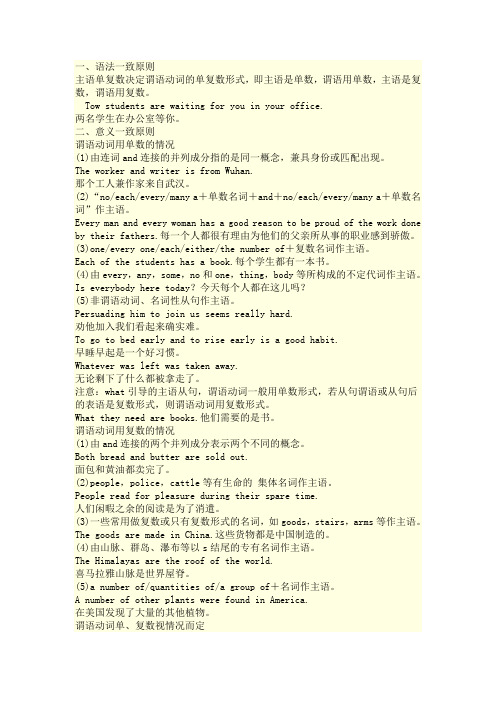
一、语法一致原则主语单复数决定谓语动词的单复数形式,即主语是单数,谓语用单数,主语是复数,谓语用复数。
Tow students are waiting for you in your office.两名学生在办公室等你。
二、意义一致原则谓语动词用单数的情况(1)由连词and连接的并列成分指的是同一概念,兼具身份或匹配出现。
The worker and writer is from Wuhan.那个工人兼作家来自武汉。
(2)“no/each/every/many a+单数名词+and+no/each/every/many a+单数名词”作主语。
Every man and every woman has a good reason to be proud of the work done by their fathers.每一个人都很有理由为他们的父亲所从事的职业感到骄傲。
(3)one/every one/each/either/the number of+复数名词作主语。
Each of the students has a book.每个学生都有一本书。
(4)由every,any,some,no和one,thing,body等所构成的不定代词作主语。
Is everybody here today?今天每个人都在这儿吗?(5)非谓语动词、名词性从句作主语。
Persuading him to join us seems really hard.劝他加入我们看起来确实难。
To go to bed early and to rise early is a good habit.早睡早起是一个好习惯。
Whatever was left was taken away.无论剩下了什么都被拿走了。
注意:what引导的主语从句,谓语动词一般用单数形式,若从句谓语或从句后的表语是复数形式,则谓语动词用复数形式。
What they need are books.他们需要的是书。
高中英语语法主谓一致
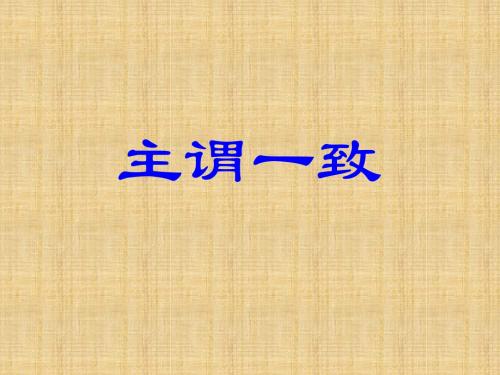
主谓一致
主谓一致的概念:主语和其谓语动词在人称 和数上保持一致。 主谓一致分为三种情况: 语法一致 意义一致
就近一致
语法一致:
语法一致是指主语和谓语在单复数形式 上的一致关系,主语为单数形式,谓语 动词用单数形式;主语为复数形式,谓 语动词用复数形式。
语法一致
(1) 如果主语后面跟有with、together with, along with, as well as, but, except, besides, in addition to, like,including, as much as, rather than, more than, no less than 等短语 再加一个名词时,谓语动词仍与主语(第一个 词)保持一致。如: 1) Mr. Johnson as well as his wife and is (be) visiting the Great Wall children ___ now. have (have) gone to the 2) All but Tom _____ cinema.
语法一致
(9) “a/an + 名词 + and a half”, “one and a half +名词” “the number of + 名词” 等作主 语时,谓语动词要用单数。如:
is (be) on the table. 1) An apple and a half ___ has (have) passed. 2) One and a half days ____ 3) The number of the students in our is (be) 63. class ____
语法一致
高考英语语法:主谓一致
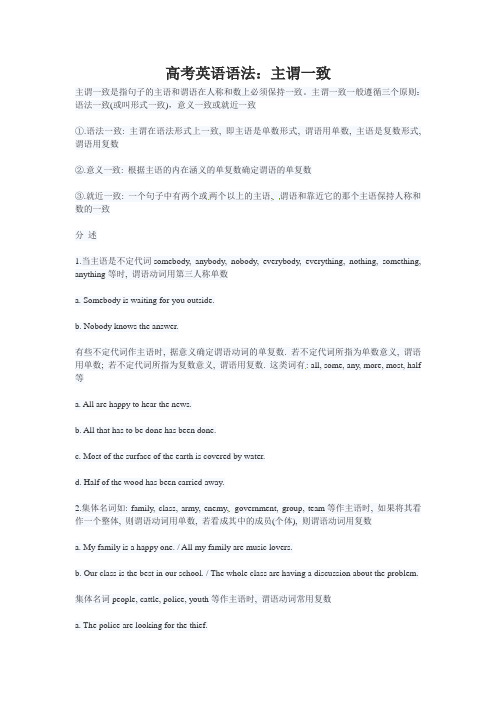
高考英语语法:主谓一致主谓一致是指句子的主语和谓语在人称和数上必须保持一致。
主谓一致一般遵循三个原则:语法一致(或叫形式一致),意义一致或就近一致①.语法一致: 主谓在语法形式上一致, 即主语是单数形式, 谓语用单数, 主语是复数形式, 谓语用复数②.意义一致: 根据主语的内在涵义的单复数确定谓语的单复数③.就近一致: 一个句子中有两个或两个以上的主语,谓语和靠近它的那个主语保持人称和数的一致分述1.当主语是不定代词somebody, anybody, nobody, everybody, everything, nothing, something, anything等时, 谓语动词用第三人称单数a. Somebody is waiting for you outside.b. Nobody knows the answer.有些不定代词作主语时, 据意义确定谓语动词的单复数. 若不定代词所指为单数意义, 谓语用单数; 若不定代词所指为复数意义, 谓语用复数. 这类词有: all, some, any, more, most, half 等a. All are happy to hear the news.b. All that has to be done has been done.c. Most of the surface of the earth is covered by water.d. Half of the wood has been carried away.2.集体名词如: family, class, army, enemy,government, group, team等作主语时, 如果将其看作一个整体, 则谓语动词用单数, 若看成其中的成员(个体), 则谓语动词用复数a. My family is a happy one. / All my family are music lovers.b. Our class is the best in our school. / The whole class are having a discussion about the problem.集体名词people, cattle, police, youth等作主语时, 谓语动词常用复数a. The police are looking for the thief.b. Cattle are not allowed to graze here.3.代词none和neither作主语时, 谓语动词根据说话人的意思用单数或复数. 当说话人着眼于任何一个都不时, 谓语动词用单数; 当说话人着眼于全都不时, 谓语动词用复数a. None of them has a car. ( 他们没有一个人有汽车)b. None of them have a car. ( 他们都没有汽车)c. None of them knows the answer. ( 他们两个谁也不知道答案)d. None of them know the answer. ( 他们两个都不知道答案)4.bothand连接两个主语时, 谓语动词通常用复数. eitheror, neithernor, not onlybut also, notbut 连接两个主语时, 采取就近原则, 即谓语动词和靠近它的那个主语保持一致a. Both Tom and Jerry were late for school that day.b. Either you or he has dropped waste paper in the street.c. Neither he nor I have forgotten for pay for the drinks.5.在There be和Here be结构中, 句子的主语在be之后, 如果主语不止一个, 那么谓语动词be与邻近的主语一致a. There is a desk, a table, three chairs in the room.b. There are three chairs, a desk and a table in the room.c. Here are two letters and a magazine for you.6.如果主语后面跟有with, together with, along with, as well as, but, except, besi des, including, like, rather than, no less than, in addition to(除外)等引导的短语时, 谓语动词的形式只与主语有关, 而与其后的短语无关a. The teacher with three student s was in the classroom then.b. This book, as well as the other two books, is borrowed from our school library.c. None but Jim and Mike knows my secret.d. Seven people, including a policeman, were killed.7.表示时间, 长度, 距离, 金额, 价值, 重量, 容量等的复数名词作主语时, 通常作整体看待, 即表示总量或总和, 谓语动词用单数. 若把它们看作一个个的个体, 即强调其具体数量时, 谓语动词用复数形式a. Twenty years is a long time to us.b. Two hundred miles is not a long distance.c. Ten thousand US dollars is a lot of money.d. There are ten minutes left.8.在四则运算中, 谓语动词用单复数均可, 但单数形式更为多用a. Two and ten is / are twelve.b. Three times five is / are fifteen.9.动名词或动词不定式作主语时, 谓语动词用单数a. Smoking / To smoke is a bad habit.b. Carving animal bones is not an easy job.10.主语从句作主语时, 谓语动词通常用单数. 但若主语从句所指的具体内容为复数意义时, 谓语动词用复数a. What we need is more time.b. What we need are more doctors.11.以-s结尾的专有名词作主语时, 谓语动词通常用单数, 这类专有名词如: General Motors(通用汽车公司), the United Nations(联合国), the United States, the New York Times(纽约时报)等.a. The New York Times is published daily.b. The Arabian Nights is a popular reading among the young people.表示群岛, 山脉, 瀑布的专有名词作主语时, 谓语动词通常用复数, 如:the Andes(安第斯山脉), the Alps(阿尔卑斯山脉), the West Indies(西印度群岛), the Niagara Falls(尼加拉大瀑布)12.有些形式为复数, 而意义为单数的名词作主语时, 谓语动词用单数. 这类名词如: news, works(工厂), politics(政治), physics(物理), mathematics(数学 )等13.以-s或-es结尾, 由对称的两部分构成的物体作主语时, 谓语动词用复数. 这类物体如: trousers, glasses, jeans(牛仔裤), scissors(剪刀), shades(太阳镜)等. 如果这类名词前用了pair, 则谓语动词的数取决于pair的数a. Here is a pair of glasses for you.b. There are three pairs of jeans in the bag.14. 分数或百分数+ of + 名词作主语时, 谓语动词视名词的可数与否采用单数或复数a. Over three quarters of the city was destroyed in the war.b. 35 percent of the do ctors are women.c. Thirty percent of the workers are out of work now.d. One third of the water has been wasted.15.用and连接两个或两个以上的单数名词作主语时, 谓语动词用复数. 如果and连接的两个名词指的是同一人、事、物或概念( 如: a knife and f ork一副刀叉, the bread and butter奶油面包, my house and home我的家)时, 则谓语动词用单数a. Many books and a pen are on the desk.b. The pianist and composer (钢琴家兼作曲家) has come to this small town.16. the + adj.表示一类人或事物作主语时, 谓语动词用复数. the +adj.若表示抽象概念或品质, 则谓语用单数a. The old in the city are taken good care of.b. The beautiful gives pleasure to all of us.美给我们以快乐17.more than one和many a + 单数名词作主语时, 谓语用单数a. Many a student has won the prize.很多学生获了奖b. More than one person has made the same mistake.不止一人犯了同样的错误。
【高中英语】高中英语语法之主谓一致

【高中英语】高中英语语法之主谓一致除了课堂上的学习外,平时的积累与练习也是学生提高成绩的重要途径,本文为大家提供了高中英语语法之主谓一致,祝大家阅读愉快。
(1)邻近原理①由并列结构或连词(either…or,neither…nor,not…but,notonly…butalso,or等)连接的并列主语,谓语动词与靠近的那个名词或代词保持一致。
他的父母中没有一个是汤姆。
汤姆和他的父母都不在家。
注:如果由“非此即彼、非此即彼、非此即彼或”连接的两个主语是一个复合词,最好将复数主语置于复数动词之后。
②在倒装句和therebe句型中,谓语动词与后面的第一个主语保持一致。
桌子上有一本书和几本书。
桌子上有一本书和几支钢笔。
③ 在定语从句中,关系代词是主语,其谓语动词应与其所指的先行词一致。
iknowthemanwhoistalkingtomyfather.我认识和我父亲说话的那个人。
④在强调句中,连接代词又在句中作主语,这时它应与被强调的主语保持一致。
这可能是在事故中受伤的其他人。
是玛丽的哥哥在车祸中受伤了。
(2)意义一致性原则①当主语与谓语动词之间插入alongwith,with,aswellas,togetherwith,nolessthan,besides,except,but,including等短语时,谓语动词不受这些插入语的干扰,依然和主语保持一致。
i、下个月我会和我的老师一起去上海。
我,还有我姐姐,打算下个月去上海。
② 在英语中,有一种单数和复数词(people、means、sheet、deer、fish等),其单数和复数取决于其在句子中的意义。
allofthepeopleinthecountryhavebeenpreparedforthegreatreformation.这个国家的人民已经准备好迎接巨大的变革。
③多数情况下,由“what”引导的名词性从句作主语时,其后的谓语动词通常用单数形式。
高中英语主谓一致讲解(整理版)
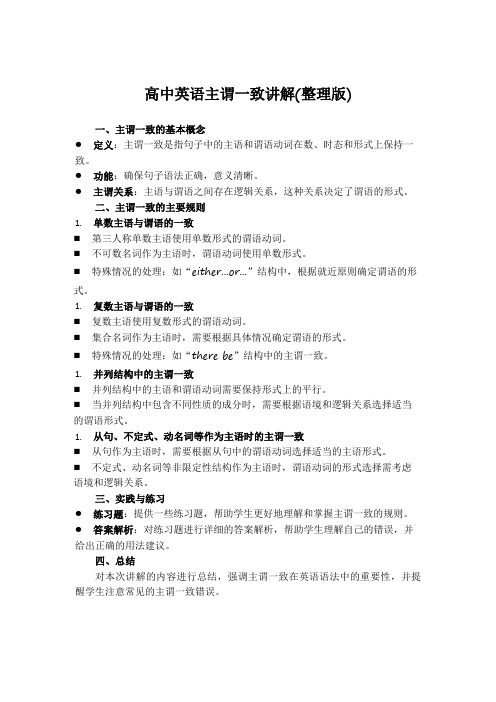
高中英语主谓一致讲解(整理版)
一、主谓一致的基本概念
●定义:主谓一致是指句子中的主语和谓语动词在数、时态和形式上保持一致。
●功能:确保句子语法正确,意义清晰。
●主谓关系:主语与谓语之间存在逻辑关系,这种关系决定了谓语的形式。
二、主谓一致的主要规则
1.单数主语与谓语的一致
⏹第三人称单数主语使用单数形式的谓语动词。
⏹不可数名词作为主语时,谓语动词使用单数形式。
⏹特殊情况的处理:如“either...or...”结构中,根据就近原则确定谓语的形式。
1.复数主语与谓语的一致
⏹复数主语使用复数形式的谓语动词。
⏹集合名词作为主语时,需要根据具体情况确定谓语的形式。
⏹特殊情况的处理:如“there be”结构中的主谓一致。
1.并列结构中的主谓一致
⏹并列结构中的主语和谓语动词需要保持形式上的平行。
⏹当并列结构中包含不同性质的成分时,需要根据语境和逻辑关系选择适当的谓语形式。
1.从句、不定式、动名词等作为主语时的主谓一致
⏹从句作为主语时,需要根据从句中的谓语动词选择适当的主语形式。
⏹不定式、动名词等非限定性结构作为主语时,谓语动词的形式选择需考虑语境和逻辑关系。
三、实践与练习
●练习题:提供一些练习题,帮助学生更好地理解和掌握主谓一致的规则。
●答案解析:对练习题进行详细的答案解析,帮助学生理解自己的错误,并给出正确的用法建议。
四、总结
对本次讲解的内容进行总结,强调主谓一致在英语语法中的重要性,并提醒学生注意常见的主谓一致错误。
高中英语语法梳理-主谓一致
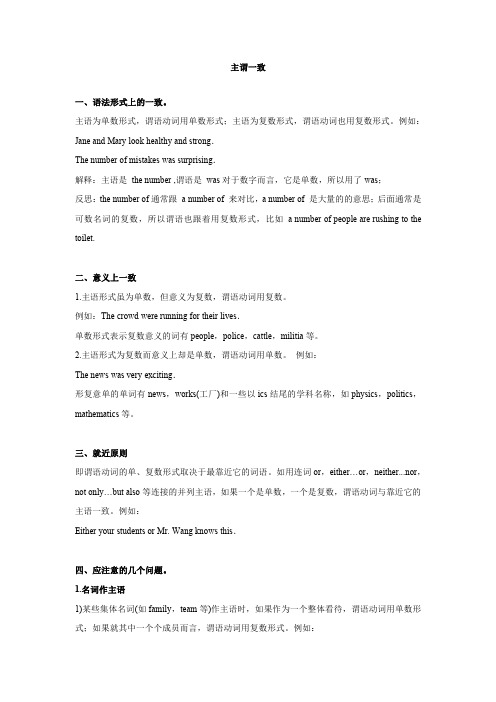
主谓一致一、语法形式上的一致。
主语为单数形式,谓语动词用单数形式;主语为复数形式,谓语动词也用复数形式。
例如:Jane and Mary look healthy and strong.The number of mistakes was surprising.解释:主语是the number,谓语是was对于数字而言,它是单数,所以用了was;反思:the number of通常跟a number of来对比,a number of是大量的的意思;后面通常是可数名词的复数,所以谓语也跟着用复数形式,比如a number of people are rushing to the toilet.二、意义上一致1.主语形式虽为单数,但意义为复数,谓语动词用复数。
例如:The crowd were running for their lives.单数形式表示复数意义的词有people,police,cattle,militia等。
2.主语形式为复数而意义上却是单数,谓语动词用单数。
例如:The news was very exciting.形复意单的单词有news,works(工厂)和一些以ics结尾的学科名称,如physics,politics,mathematics等。
三、就近原则即谓语动词的单、复数形式取决于最靠近它的词语。
如用连词or,either…or,neither...nor,not only…but also等连接的并列主语,如果一个是单数,一个是复数,谓语动词与靠近它的主语一致。
例如:Either your students or Mr.Wang knows this.四、应注意的几个问题。
1.名词作主语1)某些集体名词(如family,team等)作主语时,如果作为一个整体看待,谓语动词用单数形式;如果就其中一个个成员而言,谓语动词用复数形式。
例如:The whole family are watching TV.His family is going to have a long journey.这类名词有:audience,class,club,committee,company,crew,crowd,enemy,government,group,party,public,team,etc.名词population一词的使用情况跟上述类似。
高中英语语法 主谓一致

主谓一致主谓一致,指主语与谓语之间在数与人称上保持一致。
其中,最重要的是数的一致,即主语的单/复数决定谓语的单/复数。
如:I bought three watches yesterday. -(e)s)He watches TV every day. (watch是动词,单数时加-(e)s)主谓一致有三大原则:1. 语法一致:主语和谓语从语法形式上取得一致:主语是单数形式,谓语也采取单数形式;主语是复数形式,谓语亦采取复数形式。
例如:The number of errors was surprising. 错误之多是惊人的。
We love our motherland. 我们热爱我们的祖国。
2. 意义一致:谓语的一致不是根据其外部语法形态来决定,而是取决于主语所表达的内在含义。
主语形式虽为单数,但在意义上却为复数,谓语动词应采取复数形式;主语形式虽为复数,但在意义上视为单数,谓语动词应采取单数形式。
例如:The crowd were fighting for their lives. 这些人正为生存而战斗。
Three years in a strange land seems like a long time. 在异乡生活的三年仿佛是很长的时间。
3. 就近一致:谓语动词根据它前面最邻近的名词或代词或其他词的数的形式,来决定其自身的数的形式。
例如:Not only his children but also he wants to go there.Either my wife or I am going to work there.使用主谓一致原则,首先得找到句子的主语。
谓语左边紧挨着的词或短语,并非就是主语。
常见有三种情况妨碍我们找到主语:1. 定语或状语(如介词短语)的干扰。
主语后常跟的定语或状语有:①表示增加的:with, along with, together with;as well as, as much as;in addition to, accompanied by, besides, plus等。
英语语法---主谓一致

第一讲主谓一致“一致”(Concord 或Agreement)是指句子成分之间词语之间在语法形式上的协调关系。
主要有主语与动词的一致,主语与补语的一致,限定词与名词中心词的一致,人称代词与并列和非并列先行词的一致,名词与名词或代词的一致。
“主谓一致”是指主语和谓语动词之间在人称和数的方面的一致关系,这又叫做“主——动一致”(Subject ——verb Concord)。
1. 主谓一致三原则主语和随后的动词(词组),即谓语动词之间的一致关系常为三种不同的原则所支配,即语法一致原则(Grammar Concord),意义一致原则(Notional Concord)和就近原则(Principle of Proximity)。
1.1 语法一致指作主语的名词中心词是复数,动词就用复数形式;如果名词中心词是单数名词或不可数名词,动词就用单数形式。
例如:Both boys have their own merits.In my heart are peace and goodwill.The elevator works very well.Much effort is wasted.1.2 意义∕概念一直指主语和动词的一致关系并非取决于语法上的单、复数形式,而是取决于主语的单、复数意义。
有时主语在语法形式上并非复数,但有复数意义,随后的动词就用复数;主语在语法形式上是复数,而在意义上可视为单数,随后的动词用单数。
例如:The jury has asked more time.The jury are unable to agree.Fifty minutes isn’t enough time to finish this test.“ Senior citizens” means people over sixty.1.3 就近原则指谓语动词的单、复数形式取决于最靠近它的词语的单、复数形式,而不是与充当主语的名词短语中心词相一致。
高中英语语法主谓一致详细讲解
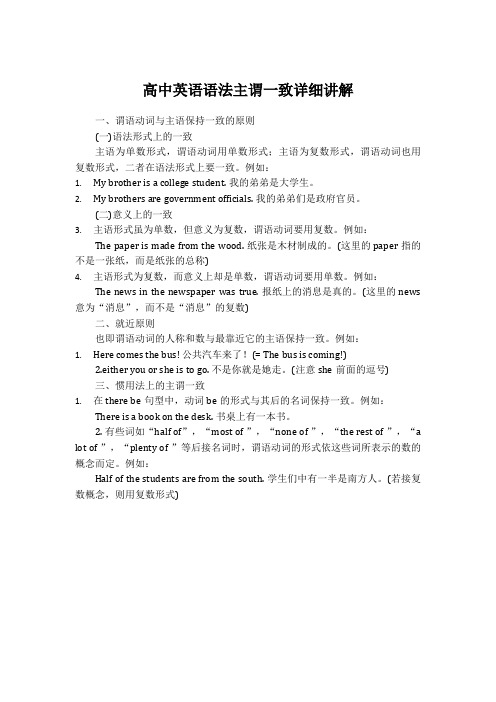
高中英语语法主谓一致详细讲解一、谓语动词与主语保持一致的原则(一)语法形式上的一致主语为单数形式,谓语动词用单数形式;主语为复数形式,谓语动词也用复数形式,二者在语法形式上要一致。
例如:1.My brother is a college student. 我的弟弟是大学生。
2.My brothers are government officials. 我的弟弟们是政府官员。
(二)意义上的一致3.主语形式虽为单数,但意义为复数,谓语动词要用复数。
例如:The paper is made from the wood. 纸张是木材制成的。
(这里的paper 指的不是一张纸,而是纸张的总称)4.主语形式为复数,而意义上却是单数,谓语动词要用单数。
例如:The news in the newspaper was true. 报纸上的消息是真的。
(这里的news 意为“消息”,而不是“消息”的复数)二、就近原则也即谓语动词的人称和数与最靠近它的主语保持一致。
例如:1.Here comes the bus! 公共汽车来了!(= The bus is coming!)2.either you or she is to go. 不是你就是她走。
(注意she前面的逗号)三、惯用法上的主谓一致1.在there be句型中,动词be的形式与其后的名词保持一致。
例如:There is a book on the desk. 书桌上有一本书。
2. 有些词如“half of”,“most of ”,“none of ”,“the rest of ”,“a lot of ”,“plenty of ”等后接名词时,谓语动词的形式依这些词所表示的数的概念而定。
例如:Half of the students are from the south. 学生们中有一半是南方人。
(若接复数概念,则用复数形式)。
高考英语语法——主谓一致

高考英语语法——主谓一致在英语表达中,句子中的谓语动词在人称和数上要和主语保持一致,我们称之为“主谓一致”。
要做到主谓一致,除了要考虑句中主语的人称和数的变化外,还要考虑到谓语动词的时态和语态的变化。
在这一章中,以主语的变化为主导,引出谓语的可归纳性变化。
主要从并列结构作主语时与谓语的一致和单一主语情况下对谓语的要求,以及其他一些特殊情况下的主谓一致三部分讲解。
典型例句:1.Either he or I am wrong.不是他错了,就是我错了。
2.The singer and dancer comes from Shanghai.那位歌舞演员来自上海。
3.A number of students like playing football.许多学生喜欢踢足球。
一、并列结构作主语时的主谓一致1.由and连接主语时由and连接的两个或多个单数可数名词、不可数名词或者代词作主语时,要根据并列主语所表达的意义或概念来确定谓语动词的单复数形式,可以分为下列几种情况。
A.并列主语表示不同的人、物或概念时,谓语动词用复数形式。
Li Ming and Zhang Hua are good students.李明和张华是好学生。
Like many others,the little tramp and the naughty boy have rushed there is search of gold.像许多其他人一样,这个小流浪汉和这个顽皮的小男孩儿也赶到那儿去寻找金子。
Both rice and wheat are grown in this area.这个地区种植大米和小麦。
(切记:both...and...结构作主语时,谓语动词用复数形式。
)B.并列主语表示同一个人、物或概念时,谓语动词用单数形式。
The professor and writer is speaking at the meeting.那位教授兼作家正在会上发言。
高中语法----主谓一致
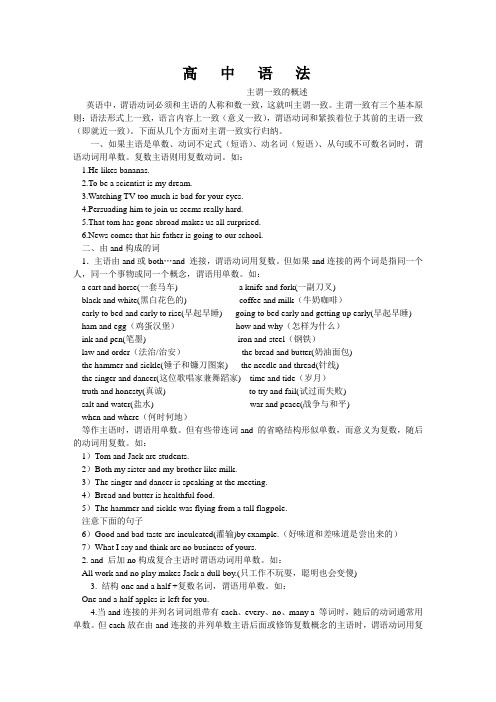
高中语法----主谓一致的概述英语中,谓语动词必须和主语的人称和数一致,这就叫主谓一致。
主谓一致有三个基本原则:语法形式上一致,语言内容上一致(意义一致),谓语动词和紧挨着位于其前的主语一致(即就近一致)。
下面从几个方面对主谓一致实行归纳。
一、如果主语是单数、动词不定式(短语)、动名词(短语)、从句或不可数名词时,谓语动词用单数。
复数主语则用复数动词。
如:1.He likes bananas.2.To be a scientist is my dream.3.Watching TV too much is bad for your eyes.4.Persuading him to join us seems really hard.5.That tom has gone abroad makes us all surprised.6.News comes that his father is going to our school.二、由and构成的词1.主语由and或both…and 连接,谓语动词用复数。
但如果and连接的两个词是指同一个人,同一个事物或同一个概念,谓语用单数。
如:a cart and horse(一套马车) a knife and fork(一副刀叉)black and white(黑白花色的) coffee and milk(牛奶咖啡)early to bed and early to rise(早起早睡) going to bed early and getting up early(早起早睡) ham and egg(鸡蛋汉堡)how and why(怎样为什么)ink and pen(笔墨) iron and steel(钢铁)law and order(法治/治安)the bread and butter(奶油面包)the hammer and sickle(锤子和镰刀图案) the needle and thread(针线)the singer and dancer(这位歌唱家兼舞蹈家) time and tide(岁月)truth and honesty(真诚) to try and fail(试过而失败)salt and water(盐水) war and peace(战争与和平)when and where(何时何地)等作主语时,谓语用单数。
高中英语语法全解-主谓一致

第十六章主谓一致主谓一致(concord),是指主语和谓语动词要保持人称和数上的一致。
英语中动词be的变化形式最多,如I am,You are,He is,We are等。
主语I一定要用am 的动词形式,这就叫“主谓一致”。
一、主谓一致的三个原则主谓一致涉及三个基本原则,即语法一致原则(principle of grammatical concord)、意义一致原则(principle of notional concord)和就近原则(principle of proximity)。
A.语法一致语法一致是指主语和谓语在单复数形式上的一致关系,主语为单数形式,谓语动词用单数形式;反之,谓语动词用复数形式。
My child has no intention of spending a vacation with me. 我的孩子不想与我一起度假。
My children have no intention of spending a vacation with me. 我的孩子们不想与我一起度假。
B.意义一致意义一致是说谓语动词的单、复数要取决于主语所表达的概念,而不取决于表面上的语法标记。
1. 主语形式虽为单数,但意义为复数,谓语动词用复数。
The only people who are interested in the book seem to be lawyers. 唯一对这本书感兴趣的人好像是律师。
The majority of primary school teachers are women. 大多数小学老师都是女的。
2. 主语形式为复数,而意义上却是单数,谓语动词用单数。
No news is good news. 没有消息就是好消息。
Billiards is becoming more and more popular in some cities. 桌球在一些城市里越来越受欢迎。
C.就近原则就近原则是指当主语由两个或两个以上名词或代词组成时,谓语动词的数要与它紧邻的名词或代词的数一致。
高中语法之主谓一致

一. 概念:主谓一致是指:(1) 语法形式上要一致,即单复数形式与谓语要一致。
(2) 意义上要一致,即主语意义上的单复数要与谓语的单复数形式一致。
(3) 就近原则,即谓语动词的单复形式取决于最靠近它的词语。
一般来说,不可数名词用动词单数,可数名词复数用动词复数。
例如: There is much water in the thermos.但当不可数名词前有表示数量的复数名词时,谓语动词用复数形式。
例如: Ten thousand tons of coal were produced last year.二. 相关知识点精讲1. 并列结构作主语时谓语用复数例如:Reading and writing are very important. 读写很重要。
注意:当主语由and连结时,如果它表示一个单一的概念,即指同一人或同一物时,谓语动词用单数,and 此时连接的两个词前只有一个冠词。
例如:The iron and steel industry is very important to our life. 钢铁工业对我们的生活有重要意义。
典型例题:The League secretary and monitor ___ asked to make a speech at the meeting.A. isB. wasC. areD. were答案: B注:先从时态上考虑。
这是过去发生的事情应用过去时,先排除A,C。
本题易误选D,因为The League secretary and monitor 好象是两个人,但仔细辨别,monitor 前没有the,在英语中,当一人兼数职时只在第一个职务前加定冠词。
后面的职务用and 相连。
这样本题主语为一个人,所以应选B。
2. 主谓一致中的靠近原则(1) 当there be 句型的主语是一系列事物时谓语应与最邻近的主语保持一致。
例如:There is a pen, a knife and several books on the desk. 桌上有一支笔、一把小刀和几本书。
高中英语语法-主谓一致详解及练习
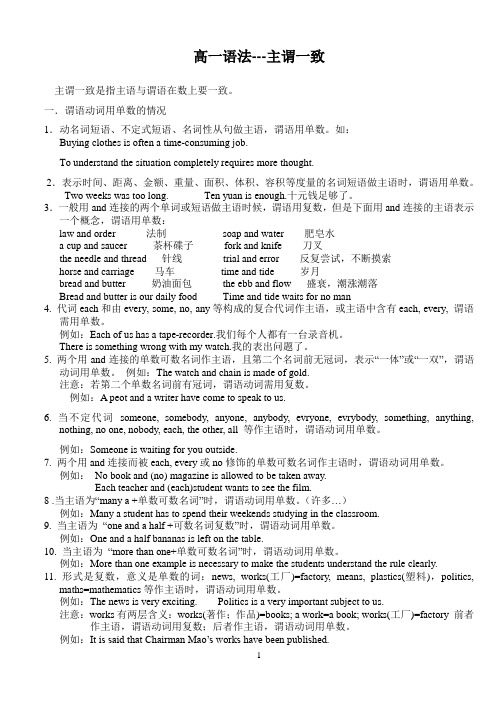
高一语法---主谓一致主谓一致是指主语与谓语在数上要一致。
一.谓语动词用单数的情况1.动名词短语、不定式短语、名词性从句做主语,谓语用单数。
如:Buying clothes is often a time-consuming job.To understand the situation completely requires more thought.2.表示时间、距离、金额、重量、面积、体积、容积等度量的名词短语做主语时,谓语用单数。
Two weeks was too long. Ten yuan is enough.十元钱足够了。
3.一般用and连接的两个单词或短语做主语时候,谓语用复数,但是下面用and连接的主语表示一个概念,谓语用单数:law and order 法制soap and water 肥皂水a cup and saucer 茶杯碟子fork and knife 刀叉the needle and thread 针线trial and error 反复尝试,不断摸索horse and carriage 马车time and tide 岁月bread and butter 奶油面包the ebb and flow 盛衰,潮涨潮落Bread and butter is our daily food Time and tide waits for no man4. 代词each和由every, some, no, any等构成的复合代词作主语,或主语中含有each, every, 谓语需用单数。
例如:Each of us has a tape-recorder.我们每个人都有一台录音机。
There is something wrong with my watch.我的表出问题了。
5. 两个用and连接的单数可数名词作主语,且第二个名词前无冠词,表示“一体”或“一双”,谓语动词用单数。
高中英语语法系统讲解之十二主谓一致

高中英语语法系统讲解之十二主谓一致主谓一致指的是句子的主语和谓语动词在人称和数上应保持一致,通常指的主谓一致是主语和谓语在单数和复数上的一致性。
一. 主谓一致的三个原则1. 语法一致原则主语单复数决定谓语动词的单复数形式,即主语是单数,谓语用单数;主语是复数,谓语用复数。
如The number of errors is surprising.Two students are waiting for you in your office.2. 意义一致原则主语形式虽为单数,但意义为复数,谓语动词用复数;主语形式为复数,但意义上为单数,谓语动词用单数。
如The crowd were running for their lives.The news was very surprising.形复意单的单词有news,works(工厂),means和以ics结尾的学科名词politics,physics,economics 等。
3. 就近原则谓语动词的单复数取决于最靠近它的词语,主要体现在由or,either … or,neither… nor …,not only … but also等连接的主语及there be …句型中。
如Nither you nor I am wrong.There is a pen, five pencils and two pencilboxes on the table.二、谓语动词用单数形式的情况1、单个的不可数名词、单数名词(尽管后面跟着with,together with,along with,like,including,as wellas,in addition to,rather than,but,except,more than等连接的短语)作主语时,谓语动词用单数式。
如:The news is going about quickly in the small town.A woman with two children has come.Helen as well as I is eager to see the performance.You rather than I are going to go camping.2、one,no one,nobody,anyone,anybody,someone,somebody,one of,every,everyone,everybody,each,either,neither等用作主语或修饰主语时,谓语动词用单数形式。
主谓一致高中英语语法与短语

主谓一致高中英语语法与短语主谓一致时,什么时候谓语用单数?什么时候用复数?如何学好英语?小编在这里整理了相关资料,快来学习学习吧!一主谓一致概念一、主谓一致概念:主谓一致,即谓语动词的单复数要和主语保持一致。
一般来说,如果主语是单数形式,那么谓语动词要用单数;如果主语是复数形式,那么谓语动词要用复数。
但是,也会出现一些特殊情况,这就是我们要总结的。
二主谓一致类型1. 不可数名词看成单数,因此谓语动词要用单数形式。
不可数名词有很多,比如空气、水、重量、长度、金钱等等。
(1) Ten thousand dollars is quite a large sum.(2) About 20 percent of the work was done yesterday.第一个句子里,钱即使再多,也只是一笔数目,所以看成单数;第二个句子里,work 是不可数的,这个要注意,在英语里,我们把 job 看成可数名词,但是 work 看成不可数名词,不可数名词的前提下,不论讲它的几分之几,还是百分之多少,都仍然是不可数。
2. 主语从句看成单数。
That they were wrong in these matters is now clear to us all.这句话里有两个动词,一个是were,另一个是 is,一个句子只能有一个动词,所以这里肯定嵌入了一个从句,我们会发现 That they were wrong in these matters 是个整体,充当整个句子里的主语,所以是主语从句。
我们把主语从句看成单数,所以这里用的 is。
3. 就前原则就前原则,指的是动词单复数看这个词前面的名词单复数情况。
as well as, with, along with, together with 都遵循就前原则。
具体我们来看以下例句:(1) E-mail, as well as telephones, plays an important part in daily communication.(2) A library with five thousand books is offered to the nationas a gift.第一句话的意思是邮件和电话在日常沟通中有重要作用。
高中英语语法主谓一致
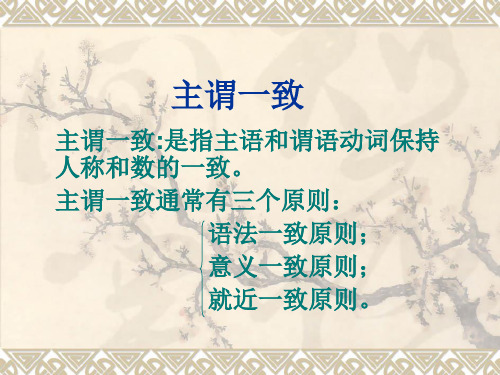
4.more than one + 名词单数; the number of + n. +谓(单) a number of+ n.+谓(复)
例如:1.The number of the students in our class____60. is 2.A number of the students have ___ (have) seen the film. 3.More than one person ____ is injured in the accident yesterday.
⑵由and和both…and…连接的两个并列成分 作主语时,谓语动词用复数。 例如:1.Both bread and butter are ___ popular with children. 2.The black and the white cat are ___ asleep. is 3.The black and white cat ___asleep. 4.Water and air are ___ necessary to people.
is made up of able men. 2.The crew ___ The crew ___ are busy with their work. 3.My family ___ is not large My family are ___ watching TV.
2.people, youth(年轻人),cattle(牛),
例如:1.This kind of apples____ is highly priced. 2. Apples of this kind____ are highly priced. 3.This pair of trousers___ is his. 4.A pair of shoes___ is under the bed. My shoes ___ are under the bed. 5.One of them____ ห้องสมุดไป่ตู้s damaged.
人教社高中英语必修 4 unit 1语法精讲精练-----主谓一致

语法精练---主谓一致必修 4 unit 1Subject-Verb agreement (主谓一致)【命题趋向】高考考察一些特殊名词在主谓一致情况下的形式,如改错,单选等题目。
【基础知识】一、主谓一致的三个原则所谓一致是指句子成分之间或词语之间在人称数、性等方面的协调关系。
主谓一致是指一个句子的主语和谓语动词保持人称与数的一致关系。
一个句子中主谓一致有三种基本原则:语法一致;意义一致;就近一致。
1)语法一致:指句中的动词要和它的主语在语法形式上保持一致。
其最基本的规则是:单数主语需要用单数动词复数主语需要用复数动词。
如:No further explanation has been given by them so far 。
到目前为止,他们还没有作出进一步的解释。
2)意义一致:从意义上看眼处理主谓一致关系,谓语动词的单、复数形式取决于主语所表达的概念,而不取决于表面的语法标志。
如:主语的语法形式为单数,但表示单数意义,谓语动词往往用单数。
如:Bread and butter is what little John enjoys. 小约翰喜欢吃涂有黄油的面包。
(主语加虽有and ,但应作为一个整体看待,即“涂了黄油的面包”。
)3)就近一致:即谓语动词的人称和数往往与最近的主语保持一致。
如:-Not only the students but also teachers should make full use of their time to improvethemselves.不仅学生而且老师也要充分利用时间提高自己。
二、主谓一致用法应用时注意的问题:1)当主语为表示“距离”,“时间”,“长度”,“价值”,“金额”,“重量”,“容量”等复数名词时,可以将其看作一个整体,谓语动词用单数。
Six months is too short a time to learn a language .六个月时间太短,不能学会一门语言。
- 1、下载文档前请自行甄别文档内容的完整性,平台不提供额外的编辑、内容补充、找答案等附加服务。
- 2、"仅部分预览"的文档,不可在线预览部分如存在完整性等问题,可反馈申请退款(可完整预览的文档不适用该条件!)。
- 3、如文档侵犯您的权益,请联系客服反馈,我们会尽快为您处理(人工客服工作时间:9:00-18:30)。
高中语法----主谓一致的概述英语中,谓语动词必须和主语的人称和数一致,这就叫主谓一致。
主谓一致有三个基本原则:语法形式上一致,语言内容上一致(意义一致),谓语动词和紧挨着位于其前的主语一致(即就近一致)。
下面从几个方面对主谓一致进行归纳。
一、如果主语是单数、动词不定式(短语)、动名词(短语)、从句或不可数名词时,谓语动词用单数。
复数主语则用复数动词。
如:1.He likes bananas.2.To be a scientist is my dream.3.Watching TV too much is bad for your eyes.4.Persuading him to join us seems really hard.5.That tom has gone abroad makes us all surprised.6.News comes that his father is going to our school.二、由and构成的词1.主语由and或both…and 连接,谓语动词用复数。
但如果and连接的两个词是指同一个人,同一个事物或同一个概念,谓语用单数。
如:a cart and horse(一套马车) a knife and fork(一副刀叉)black and white(黑白花色的) coffee and milk(牛奶咖啡)early to bed and early to rise(早起早睡) going to bed early and getting up early(早起早睡) ham and egg(鸡蛋汉堡)how and why(怎样为什么)ink and pen(笔墨) iron and steel(钢铁)law and order(法治/治安)the bread and butter(奶油面包)the hammer and sickle(锤子和镰刀图案) the needle and thread(针线)the singer and dancer(这位歌唱家兼舞蹈家) time and tide(岁月)truth and honesty(真诚) to try and fail(试过而失败)salt and water(盐水) war and peace(战争与和平)when and where(何时何地)等作主语时,谓语用单数。
但有些带连词and 的省略结构形似单数,而意义为复数,随后的动词用复数。
如:1)Tom and Jack are students.2)Both my sister and my brother like milk.3)The singer and dancer is speaking at the meeting.4)Bread and butter is healthful food.5)The hammer and sickle was flying from a tall flagpole.注意下面的句子6)Good and bad taste are inculcated(灌输)by example.(好味道和差味道是尝出来的)7)What I say and think are no business of yours.2. and 后加no构成复合主语时谓语动词用单数。
如:All work and no play makes Jack a dull boy.(只工作不玩耍,聪明也会变傻)3. 结构one and a half +复数名词,谓语用单数。
如:One and a half apples is left for you.4.当and连接的并列名词词组带有each、every、no、many a 等词时,随后的动词通常用单数。
但each放在由and连接的并列单数主语后面或修饰复数概念的主语时,谓语动词用复数形式。
如:1)Each boy and each girl has got an orange.2)No sound and no voice is heard at night.3)The boy and the girl each have their own toys.(注意)4)They each have an English-Chinese dictionary.三、两个作主语用的名词或代词由neither…nor, either…or, not only…but also,…or…, not…but, whether…or连接时,谓语动词应和后面的名词或代词的人称和数保持一致,即就近原则。
倒装句、here、be、there be、one in ten结构中谓语动词也遵循就近原则。
注意:one out of ten, one in ten在非正式文体中遵循就近原则,但在正式文体中谓语用单数,如:1.Not only the boys but also the father was to blame.2.Either you or the headmaster is to hand out the prizes to these gifted students.3.He or his brothers were to blame.4.Here comes the bus and two cars.5.There is a pen,five pencils and three books on the desk.6.Nine out of every ten Pakistanis is a Moslen.7.Three out of four people choose “Six Fox”soap.8.One in ten students have finished the exam.9.One in three students in the United States lives in the countryside. (高中课本P104页)四、主语为表示时间、金钱、重量、距离、数量、度量以及国家和书报名称等作为单一的概念时谓语动词用单数形式。
如:1.Ten minutes is enough.2.Twenty dollars is too expensive.3.Ten pounds was missing from the till(现金出纳机).4.Six hundred miles is a long distance.五、在定语从句中,关系代词who, that, which等作主语时,其谓语动词的数应与主句中的先行词一致。
在one of+复数名词+who/that/which引导的定语从句中,从句谓语动词常用复数。
若one前有the (only)等修饰时,从句谓语动词常用单数。
如1.He is one of the boys who often play football in the street.2.He was the only one of the persons who was invited to the ball.六、由不定代词either, neither, each, one,the other, another, anybody, anyone, anything, somebody, something, everybody, everyone, everything, nobody, no one, nothing等作主语时,谓语动词一般用单数。
如:1.Everyone is here.No one is away.2.Each of the books cost en yuan.3.Each/Every child is given a gift on Children’s Day.4.Much has been done to solve the traffic problem.5.When he came back,nothing was the same as before.七、主语表示一部分,如three-fifths of、one thirds of、twenty percent of、half of、some of、the rest of、most of、a lot of、lots of、a load of、loads of、plenty of、the majority of、all、part of等of后接可数名词时谓语动词用复数,接不可数名词时,谓语动词用单数。
a quantity of + 可数或不可数名词作主语时,谓语用单数。
quantities of + 可数或不可数名词作主语时,谓语用复数。
an amount/amounts of+U谓语的选择与quantity一样a mass/masses of +C/U谓语的选择与quantity一样a number/numbers of+C谓语用复数a group of+C谓语用复数a variety/varieties of +C/U谓语用复数a world of +U 谓语用单数a series/species/pile of + 可数名词复数+ 单数谓语two series/species of + 可数名词复数+ 复数谓语如:1.Losts of water has been wasted.2.A lot of books have been translated into English since 1980.3.The rest of the workers are still very tired.4.A part of the story is not true.(这一报道有一部分是不真实的)5.A part of the apples are bad.(一部分苹果是坏的)6.Thirty percent of the liquor is alcohol.(这酒含有百分之三十的酒精)7.Ten percent of the homes were destroyed.(有十分之一的房屋被毁坏)8.Three-fourths of the surface of the earth is water.(地球表面的四分之三是水)9.Threee-fourths of the people were illiterate.(四分之三的人是文盲)八.群体名词audience、class 、club、committee、company、crowd(人群)、crew(工作人员)、department、family、gang、government、group、jury、party、population、staff、team、等作主语时,如果强调整体,谓语动词用单数。
